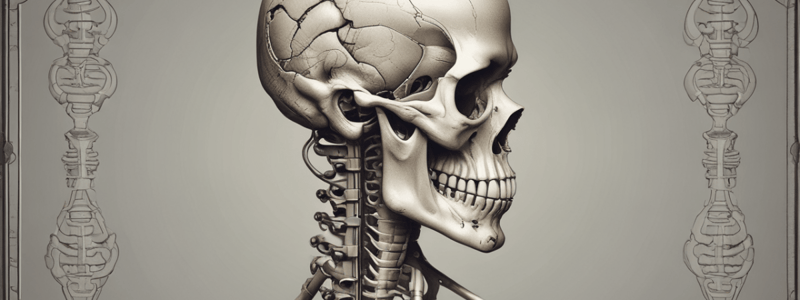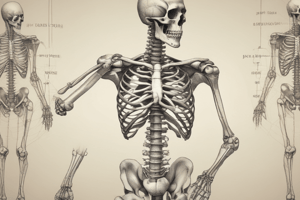Podcast
Questions and Answers
What is the name of the ridge that connects the greater and lesser trochanters on the anterior surface of the femur?
What is the name of the ridge that connects the greater and lesser trochanters on the anterior surface of the femur?
intertrochanteric line
What is the name of the bone that is located within the tendon of the quadriceps femoris muscle?
What is the name of the bone that is located within the tendon of the quadriceps femoris muscle?
patella
What is the longest bone in the human body, and what are its key features?
What is the longest bone in the human body, and what are its key features?
The femur (thigh bone) is the longest bone in the body, and its key features include a nearly spherical head that articulates with the os coxae at the acetabulum, a neck, and a shaft.
What is the name of the elevated, midline ridge on the posterior surface of the femur where many thigh muscles attach?
What is the name of the elevated, midline ridge on the posterior surface of the femur where many thigh muscles attach?
What is the function of the fovea capitis in the femur?
What is the function of the fovea capitis in the femur?
What is the name of the smooth, oval articulating surfaces on the distal, inferior surface of the femur?
What is the name of the smooth, oval articulating surfaces on the distal, inferior surface of the femur?
What is the significance of the medial angling of the femur?
What is the significance of the medial angling of the femur?
Where does the patella articulate with the femur?
Where does the patella articulate with the femur?
What are the rough processes on the femur that serve as attachment sites for powerful muscles?
What are the rough processes on the femur that serve as attachment sites for powerful muscles?
What is the name of the prominent ridge that separates the condyles of the tibia?
What is the name of the prominent ridge that separates the condyles of the tibia?
How many bones are present in each lower limb?
How many bones are present in each lower limb?
What is the name of the membrane that connects the tibia and fibula?
What is the name of the membrane that connects the tibia and fibula?
What is the function of the patella (kneecap)?
What is the function of the patella (kneecap)?
What is the function of the patella?
What is the function of the patella?
What is the anatomical region where the femur is located?
What is the anatomical region where the femur is located?
Which bone of the leg (crural region) is the weight-bearing bone?
Which bone of the leg (crural region) is the weight-bearing bone?
What is the name of the surface on the femur where the patella articulates?
What is the name of the surface on the femur where the patella articulates?
What is the name of the rough, raised projection on the distal, posterior surface of the femur?
What is the name of the rough, raised projection on the distal, posterior surface of the femur?
What is the name of the fibular articular facet located on the proximal posterolateral side of the tibia?
What is the name of the fibular articular facet located on the proximal posterolateral side of the tibia?
What is the name of the prominent process that forms on the medial border of the tibia?
What is the name of the prominent process that forms on the medial border of the tibia?
What is the function of the fibula?
What is the function of the fibula?
What is the primary function of the tibia?
What is the primary function of the tibia?
What is the name of the largest tarsal bone that forms the heel?
What is the name of the largest tarsal bone that forms the heel?
What is the name of the tarsal bone that articulates with the tibia?
What is the name of the tarsal bone that articulates with the tibia?
What are the three bones that form the proximal row of tarsal bones?
What are the three bones that form the proximal row of tarsal bones?
What is the name of the tendon that attaches to the calcaneus?
What is the name of the tendon that attaches to the calcaneus?
What are the three cuneiform bones that articulate with and are positioned anterior to the navicular bone?
What are the three cuneiform bones that articulate with and are positioned anterior to the navicular bone?
What is the name of the bone that articulates with the lateral cuneiform and calcaneus?
What is the name of the bone that articulates with the lateral cuneiform and calcaneus?
How do the bones of the foot arches contribute to maintaining their shape?
How do the bones of the foot arches contribute to maintaining their shape?
What is the primary function of the ligaments and muscles in relation to the foot arches?
What is the primary function of the ligaments and muscles in relation to the foot arches?
What is the advantage of having an arched foot over a flat foot?
What is the advantage of having an arched foot over a flat foot?
Which bones form the lateral longitudinal arch?
Which bones form the lateral longitudinal arch?
What is the orientation of the transverse arch in relation to the longitudinal arches?
What is the orientation of the transverse arch in relation to the longitudinal arches?
What bones form the transverse arch?
What bones form the transverse arch?
What is the name of the bones similar in arrangement and name to the metacarpal bones of the hand?
What is the name of the bones similar in arrangement and name to the metacarpal bones of the hand?
How many phalanges are found in the great toe?
How many phalanges are found in the great toe?
What is the name of the arch that extends from the heel to the great toe?
What is the name of the arch that extends from the heel to the great toe?
What is the name of the condition where the medial longitudinal arch is flattened so that the entire sole touches the ground?
What is the name of the condition where the medial longitudinal arch is flattened so that the entire sole touches the ground?
What is the name of the deformity where the feet are permanently inverted and the ankles are plantar flexed?
What is the name of the deformity where the feet are permanently inverted and the ankles are plantar flexed?
What is the name of the tiny bones found at the head of the first metatarsal?
What is the name of the tiny bones found at the head of the first metatarsal?
What is the name of the joint where a bunion typically occurs?
What is the name of the joint where a bunion typically occurs?
What is the name of the condition characterized by excessively high longitudinal arches?
What is the name of the condition characterized by excessively high longitudinal arches?
How many tarsal bones are present in the foot?
How many tarsal bones are present in the foot?
What is the name of the injury that occurs when repetitive pressure or stress on the foot causes a small crack to develop in the outer surface of a metatarsal?
What is the name of the injury that occurs when repetitive pressure or stress on the foot causes a small crack to develop in the outer surface of a metatarsal?
Flashcards are hidden until you start studying
Study Notes
The Lower Limb
- The lower limb consists of the thigh, leg, and foot, which enables the body to support itself during bipedal walking and running
- Each lower limb contains 30 bones
Femur and Patella
- The femur (thigh bone) is the longest, strongest, and heaviest bone in the body
- Key features of the femur:
- Head articulates with the os coxae at the acetabulum
- Fovea (depression) within the head connects to the acetabulum with a small ligament
- Neck joins the shaft at an angle, resulting in a medial angling of the femur
- Greater and lesser trochanters are rough processes that serve as attachment sites for powerful gluteal and thigh muscles
- Intertrochanteric line connects the two trochanters and marks the distal edge of the hip joint capsule
- Pectineal line and gluteal tuberosity mark the attachment of the pectineus muscle and gluteus maximus muscle, respectively
- The patella (kneecap) is a sesamoid bone located within the tendon of the quadriceps femoris muscle
- The patella articulates with the femur at the patellar surface
Tibia and Fibula
- The tibia (shinbone) is the medially placed bone and the only weight-bearing bone of the leg
- Key features of the tibia:
- Broad, superior head has two flat surfaces (medial and lateral condyles) that articulate with the femur
- Intercondylar eminence separates the condyles
- Fibular articular facet on the proximal posterolateral side articulates with the head of the fibula
- Tibial tuberosity marks the attachment site for the patellar ligament
- Medial malleolus is a prominent process on the distal medial border
- Fibular notch on the distal posterolateral side articulates with the fibula
- The fibula is a long, thin, lateral bone that does not bear weight
- Key features of the fibula:
- Rounded, knoblike head is slightly inferior and posterior to the lateral condyle of the tibia
- Neck and shaft follow the head
- Lateral malleolus is a prominent process on the distal lateral border
Tarsals, Metatarsals, and Phalanges
- The bones of the ankle and foot are the tarsals, metatarsals, and phalanges
- The seven tarsal bones are similar to the eight carpal bones of the wrist
- Key tarsal bones:
- Talus articulates with the tibia
- Calcaneus forms the heel
- Navicular bone is on the medial side of the ankle
- Cuneiform bones and cuboid bone articulate with the navicular and calcaneus
- The five metatarsal bones form the arched sole of the foot
- The phalanges (toe bones) are similar to the phalanges of the fingers and pollex
- Each toe has 3 phalanges, except for the great toe (hallux), which has 2
Arches of the Foot
- The three arches of the foot are the medial longitudinal, lateral longitudinal, and transverse arches
- The medial longitudinal arch is the highest and extends from the heel to the great toe
- The lateral longitudinal arch is lower and extends between the little toe and the heel
- The transverse arch runs perpendicular to the longitudinal arches and is formed from the distal row of tarsals and the bases of all five metatarsals
Studying That Suits You
Use AI to generate personalized quizzes and flashcards to suit your learning preferences.



